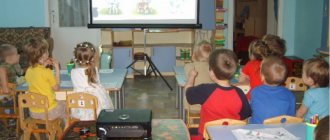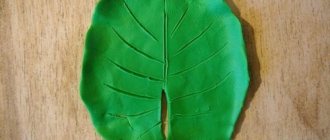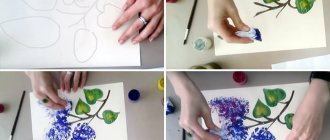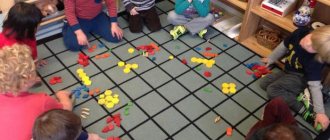Svetlana Agafonova
Summary of a lesson on the surrounding world in a preparatory group on the topic “Wild berries”
Familiarization with the outside world in the preparatory group on the topic
«
Berries
«
Tasks :
Generalization and systematization of ideas about the changes occurring in the life of the forest in autumn, about wild berries
, places of their growth;
Activation and updating of the dictionary on the topic
“
Berries ”
. Forest in autumn” (forest, swamp, berry
, cranberry, lingonberry, blueberry, cloudberry, blackberry, raspberry)
Fostering a caring attitude towards nature.
Preview:
Municipal Autonomous Educational Institution
“Gymnasium and M. N.V.
108840, Moscow, Troitsk, st. Shkolnyaya, 10, tel/fax 8(4958)-51-03-11,
"Wild berries and strawberries"
Prepared and conducted:
Ivanova Anna Viktorovna
- strengthen the ability to use a brush;
- draw with the end of the brush;
- develop productive thinking, perception of color, shape, size; fine motor skills;
- cultivate interest in creative visual activities;
- show a friendly attitude towards fairy-tale characters and a desire to help them.
— expand children’s understanding of wild berries;
- continue to introduce the features of appearance and place of their growth;
— teach to be careful with unknown berries;
- cultivate a caring attitude towards nature.
Sheets of white thick paper, watercolor paints, a round brush, a container of water, color illustrations of berries and strawberries.
Psychological game “Wishes”
Children stand in a circle.
Educator. Guys, let's imagine that the ball we hold in our hands is a little sun and we will pass it from hand to hand to a friend standing next to you with wishes (health, happiness, good friends, fun, etc.).
At the end of the game, we move on to the main part of the lesson.
Red juicy droplets of summer,
These berries are tastier than candy,
They grow together on a hillock in the forest,
I'll bring them home in a basket!
Educator. Dunno came to us today, yesterday his friend Znayka told him that strawberries are called drops of summer, but Dunno doesn’t know why they are called that, let’s help him. (Strawberries ripen in the summer and turn red in the clearing, hanging like a drop from the end of a thin stem. These berries are very aromatic and fragrant.)
Looking at an illustration depicting berries.
— What are they in color and shape? (Strawberries are small, small, round, oval, they are red in color, with white small seeds.)
— What kind of leaves does the strawberry bush have? (Green, carved.)
—What do strawberries taste like? (Sweet, juicy, tastier than candy.)
—Where do strawberries grow? (On the edges of the forest, in sunlit forest clearings.)
- Why is this berry called strawberry? (This berry grows near the ground, as if clinging to it.)
Educator. Children, Dunno invites us to color the strawberries so that we can see them among the green grass. What color watercolor paint will you choose?
Finger gymnastics “Picking berries”
One two three four five
We're going for a walk in the forest,
We'll find strawberries
We'll bring it to my brother too.
(Children “greet” each other with the fingers of both hands. Now they “walk.” Bend one finger at a time.
The teacher hangs the children's drawings on the board or lays them out on the carpet. “We found ourselves in a strawberry meadow. Would you like to pick these berries and put them in a basket?”
On the topic: methodological developments, presentations and notes
Abstract of OOD on artistic design in the middle group.
Goal: expanding and enriching children’s knowledge about “mushrooms”, “berries”, their habitat, purpose, time of collection; generalization of children's knowledge about mushrooms and berries of our forests. Final m.
Calendar-thematic planning in the middle group on the topic “Wild berries and mushrooms.”
Using this material, it is easy and simple to introduce children to wild mushrooms and berries.
Project passport Type of project: educational - creative. Type of project: informational and creative. Duration of the project - short-term Object of study - forest and garden berries.
Introduce children to wild berries; teach children to distinguish between garden and forest berries; to educate children to respect nature. Materials and equipment: posters with images of berries; ill.
Forest journey. Purpose: to consolidate children's knowledge about the ecology of their native land. Objectives: Educational: to consolidate children's knowledge in counting to 5, comparing objects: more - less, high - low, name.
Source
Progress of the lesson.
-Children, today we will draw , but first we’ll talk about berries. What berries do we know? (cherries, sweet cherries, plums, raspberries, strawberries, currants )
And where do they grow
(in the garden, vegetable garden, dacha, forest)
What else can be said about them?
What are they like (sweet, tasty, juicy, bright, healthy)
What berries can be made from
(jams, compotes, jams)
But look at
currants . It comes in red, black, white (yellow)
.
Tasty, sweet, fragrant, full of vitamins. People collect it, eat it fresh, make jam, compotes, freeze it for the winter, and dry it. Currants grow on a bush in gardens or vegetable gardens. Let's look at it. What shape are the berries? Colors? Do they grow each berry on a branch or in a bunch ?




